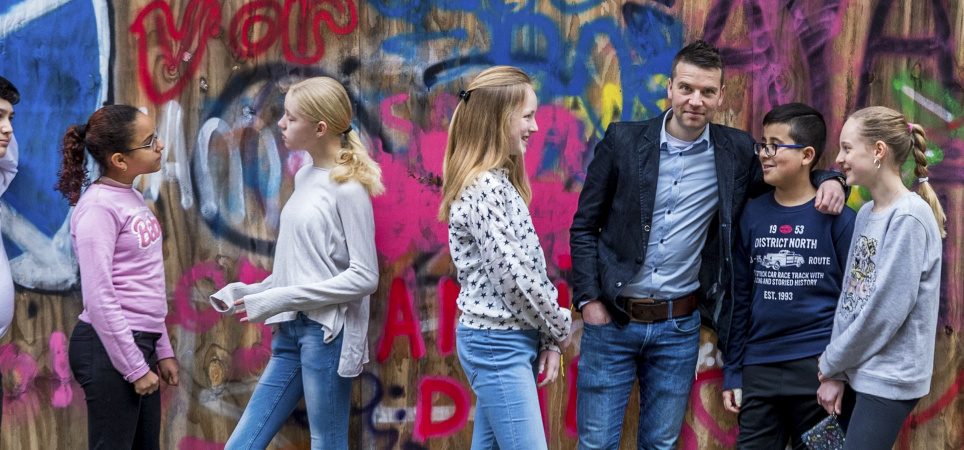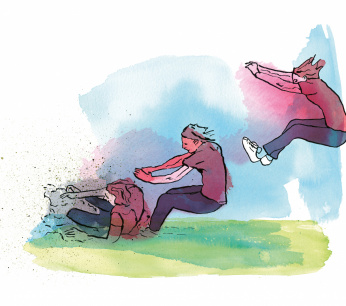Idea: an approach that is spot on
How do you deal with problem behavior? Teacher Jelle Koopman researched and devised a model for it: Rakis.

Image: Angeliek de Jonge
Refusal to participate, bad language or clownish behavior. These are examples of externalizing problem behavior that make appropriate education a major challenge. “If you zoom in, it only concerns a few students, mostly boys, whose behavior has a major influence on the rest,” says Jelle Koopman, counselor for appropriate education at Altra Education and Youth Care. Previously, he worked as a physical education teacher, care coordinator and career counselor in VMBO. He saw colleagues struggling and young people drop out and decided to conduct research into dealing with problem behavior for the master's Special Educational Needs. His conclusion: there are limits, but also answers. “Providing appropriate education is complex. Simply putting a patch on a problem is not a solution. But you can look at what works. ”
"Providing appropriate education is complex. Simply sticking a Band-Aid on a problem is not a solution," says Jelle Koopmaan, supervisor of appropriate education
To this end, he developed the Rakis method ('an approach that hits the spot'), in which the letters stand for relationship, agreements, knowledge, insight and together. According to him, all five aspects are necessary to be able to deal with problem behavior in the classroom. “Teachers often score high on the first two, a good relationship with students and effective class management. The most profit can be made in the last three. Teachers have a big heart for their students, but they often lack knowledge and insight in their actions. ”
Behaviour
Teachers do not need to become behavioral specialists, Koopman emphasizes. “The knowledge is often present in a team, but it is not always put to good use. At the beginning of the school year, sit together to see what is needed and who is strong at what. You can also call on the internal counselor or remedial educationalist for knowledge about disorders. ”
In addition, insight into one's own behavior is also important. Not infrequently behavioral problems disappear when the teacher's behavior changes. 'How do I come across' is a question that every teacher should ask his class, according to Koopman. “My research shows that teachers think they provide structure, predictability and clarity, but that students often see this as strict and angry,” he explains. “There is often no room for personal input. As soon as students feel they are taken seriously, they will go through the fire for you. ”
My research shows that teachers think they provide structure, predictability, and clarity, but students often see this as stern and angry.
That's also where the 's' of together comes into play. “Pupils themselves find it annoying that it is so busy. When you ask them what they need to be a top class, they often say that teachers need to be much more consistent. A joint approach at school with unambiguous rules helps with this. ”
His method can be used in educational teams, but also for student discussions and peer consultations, for example. More and more teachers see the benefits, he says. “A questionnaire makes it easy to see how things are going on the five aspects. It is nice to hear what you are super good at, but also where there is still room for improvement. It is a process that does not stop. There are always new classes with new students and new challenges. ”
Safety
His method offers answers, but where are the limits? “As soon as safety in the group is at stake, action must be taken”, Koopman believes. “I can imagine that is the case when fighting or calling names with illnesses. But where the boundary lies exactly, schools will have to determine together themselves. "
Of course he would also prefer to see a class with a maximum of 25 children with an assistant. “But that's not realistic now. Appropriate education is a major challenge, but I see a lot of complaints and little thinking in terms of solutions. Invest a joint approach. Sit together weekly and discuss how things are going. What do you encounter, what about the structure, where are boundaries? This means that you as a teacher are not alone and the work only becomes more fun. "
Preventing a child from dropping out is his personal drive. “I have spoken a lot with young people in juvenile prisons,” he says. “They all say that if they had been listened to before and their needs taken seriously, they wouldn't have gotten there. There is still so much to be gained in prevention. There are no miracle cures, but my method can certainly provide guidance. ”
Are you working on something interesting, or do you know someone who fits in this series, let us know via education magazine @aob. Nl


